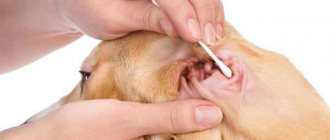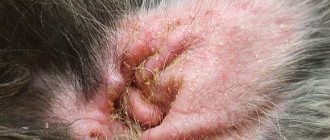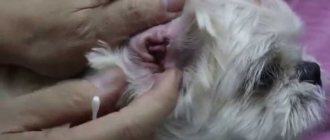Causes of ear pain
Ear diseases in dogs are a fairly common occurrence that occurs as a result of many internal and external factors.
The main cause of inflammation that develops in a dog’s ear is the specificity of their anatomical structure.
The external auditory canal in dogs is not vertical (for example, like in humans), but also has a bend in the shape of the Latin letter L.
Possible causes of ear diseases in dogs may include:
- inflammatory processes as a result of pathogenic microorganisms entering the ear;
- fungal diseases;
- pathologies of viral etiology;
- ectoparasites (ear mites);
- specific reaction to medications;
- allergic problems (food allergies);
- pathologies of the endocrine system;
- autoimmune diseases;
- wounds and scratches.
Each type of ear disease in dogs is characterized by certain symptoms. As a result of various factors, a rough coating may appear on the auricle or a specific pungent odor may arise from the ears.
Vasculitis in dogs
Vasculitis is an inflammation of the inner layer of the vascular wall (endothelium). Vasculitis can also occur as a result of improper self-treatment. Vasculitis in dogs is manifested by the characteristic appearance of scabs and ulcerative lesions in the ear area.
The pathology is an inflammatory process of an autoimmune nature, as a result of which the animal’s immunity begins to attack its own healthy cells and tissue structures. There are several causes of vasculitis - bacterial and viral microorganisms, reactions to specific medications, vaccinations, neoplasia.
Symptoms of vasculitis on the ears of dogs are:
- ulcerations on the ear;
- swelling at the site of the lesion;
- febrile conditions in the pet;
- the animal experiences pain when its ears are touched.
Tumor in a dog's ear
Increasingly, in the clinical diagnosis of diseases in dogs, tumors appearing in various parts of the body and internal organs are encountered. A tumor in a dog’s ear occurs against the background of chronic or untreated inflammatory diseases. The neoplasm can be either malignant or benign. In addition, a hematoma in the ear, a growth or an abscess can be mistaken for a tumor.
In the case of a dog's ear hematoma, a specific seal appears, filled with blood as a result of hemorrhages (major or minor), under the skin in the ear. The vast majority of dogs diagnosed with hematomas are long-eared breeds. The main cause of hematoma is mechanical damage. Symptoms of a hematoma include itching, bleeding from the ear, and pain when the animal tries to scratch the ear.
Tumors in the ear also include common tumors - warts and papillomas. The occurrence of pathology is more often found in dogs that do not have a thick coat. The real cause of benign neoplasms is not known. As the papilloma grows, the animal experiences significant discomfort and itching in the ear, but there is no pain.
An abscess that occurs under the influence of pathogenic bacterial microflora can be diagnosed as a tumor with purulent contents. A fairly common cause of abscesses in a dog's ear is insect bites or mechanical damage. When an abscess occurs in an animal, the body temperature rises, and severe pain appears in the area of suppuration.
When a purulent sac ruptures into the inner ear, infection of the internal parts of the ear canal is possible, as well as infection of the adjacent membranes of the brain.
Otitis
The inflammatory process that occurs as a result of insect bites, formed sulfur plugs, or due to an allergy to medications is called otitis media. The main reason is the penetration of pathogenic microorganisms - fungi and bacteria - into the affected area of the skin. Depending on the location of the lesion, otitis is divided into external, middle and internal.
With external otitis, the pathological process affects the area of the ear between the opening of the ear canal and the eardrum. Otitis media affects the area located behind the eardrum, and internal otitis leads to inflammation of the labyrinths of the ear canal.
When otitis occurs, the following symptoms are characteristic:
- frequent shaking of the head (tilting one way or the other);
- loss of appetite;
- on palpation the ear is very hot;
- purulent discharge from the ear stinks;
- bloody discharge;
- hyperemia of the inner part of the ear and swelling.
It is worth remembering that otitis in dogs is dangerous, since if not treated in a timely manner, the disease becomes chronic.
The released pus can get inside the ear, causing inflammation of the membranes of the brain, or if pathogenic microflora penetrates the systemic bloodstream, it can cause infection in the pet’s blood. In both cases, death is possible.
Fungal diseases
Fungal infection in dogs' ears is a common occurrence encountered in clinical veterinary practice. The disease takes a long time to be treated and is quite problematic, but the likelihood of an absolute recovery is not always predicted.
In the vast majority of dogs, fungal microorganisms belonging to the genus Malasezia and Candida are found.
Fungal non-pathogenic microflora is always present in the body of animals. But in the event of a decrease in the body’s immune forces, due to poor nutrition, hypothermia and other factors, Malasesia begins to actively reproduce, causing serious pathological changes.
With regards to candidiasis affecting the ear, in this case everything is almost identical - yeast fungi inhabit the pet’s coat without showing themselves for a long time. When immunity decreases, characteristic symptoms of damage occur.
The main symptoms of fungal ear infection are:
- itching sensation;
- there is an unpleasant smell from the ear canal area;
- the pet becomes restless.
Against the background of irritation of the ear canal by the development of fungal microflora, the pet may refuse to eat, constantly tearing its ears with its paws until they bleed. In this case, the inflammatory process, on the contrary, begins to intensify. Scabs form in the dog’s ears with crusts of dried blood. The appearance of a characteristic fetid odor is also important - an invariable companion of yeast lesions in the ears of an animal.
Ear mite
One of the most common causes of odor and sores on the ears of dogs is ear mites. The parasite is capable of infecting both street dogs and pets living exclusively in apartment conditions.
A microscopic parasite settles in the ears of an animal, multiplying with ease, since the dog’s coat creates an excellent microclimate and protection for its life. It is not possible to notice ear mites without special research.
The appearance of ear mites can occur regardless of the age of the pet. But most often puppies and young animals suffer from this parasite. This is due to the immaturity of the pets’ body’s defenses.
The main symptoms of ear mite infestation are:
- increased production of earwax;
- thick and dark discharge from the ear;
- itching and scratched ears;
- sores appear on the tips of the dog’s ears.
The tick is able to parasitize in the dog’s ear canal for quite a long time, feeding on dead and keratinized cells, as well as tissue fluids.
If not detected and treated in a timely manner, the mite can migrate under the skin, spreading throughout the body. In this case, the animal becomes even more restless, constantly trying to thoroughly scratch its back, neck or tail.
Hematomas
Ear hematoma in dogs appears as a result of external contacts. This could be a fight with another dog, cuts from branches, bushes, plant thorns, or the result of hunting crows that can give back. Even if the pet emerged victorious from the fight, after such battles small seals may appear on the ears where blood accumulates. The bubble grows over time, and pieces of skin can die inside and pus can accumulate.
Symptoms of the disease begin literally two to three hours after the dog cuts its ears. When the owner begins to stretch this seal, the dog begins to whine in pain.
Under no circumstances should you burst or cut out the bubble yourself. If a hematoma is detected, you should contact your veterinarian.
Treatment depends on the nature of the problem:
- Most often, the pocket with blood and pus is sucked out with a syringe, the hair is pre-cut and the puncture site is treated with alcohol.
- If the first method is ineffective, all contents are promptly cleaned out.
- The wound is treated with an antiseptic, and the pet is given an antibiotic.
- Sometimes the cut bladder is drained.
- In all cases, the dog must wear a special collar.
A disease in which inflammatory processes appear in the hearing organs. Despite the fact that this disease is very common in four-legged friends, it manifests itself as a residual phenomenon after other ailments. And veterinarians usually divide it into acute and chronic forms.
Attention! The disease cannot be started. At best, the dog will simply lose his hearing. But this can develop into more terrible diseases - meningitis or encephalitis. Sepsis may also occur, as a result of which the dog may simply die.
Otitis is very common in dogs
When the disease affects the ears, the pet develops the following symptoms:
- severe ear pain;
- hearing impairments;
- swollen lymph nodes;
- open wounds and small ulcers appear on the ears;
Typically, external manifestations of the disease occur due to decreased immunity. But the cause may be burns, bites, or open wounds.
This is interesting: Drontal Plus Action for Dogs
There are varieties of the disease that differ in symptoms and treatment methods.
Allergic otitis media in dogs occurs when the microflora of the ear changes. Harmful bacteria appear inside, which provoke inflammatory processes. The doctor prescribes Sofradex ear drops and additionally antiallergic drugs such as Cetrina or any other similar drug.
Allergic otitis is provoked by pathogenic microbes
The infection increases the number of harmful bacteria and fungal forms. Consequently, the dog is not able to cope with so many microbes. In this case, an inflammatory process appears, and then a course of antibiotics is started.
Tick-borne otitis media in dogs is caused by a tick, which causes very unpleasant itching. As a result, the dog scratches his ear until it bleeds. Infection penetrates through wounds, and dark, dry dirt appears in the ear canals. Treatment consists of cleaning the ear with cotton swabs, rinsing with peroxide and instilling Otinum or Otodepin drops twice a day. A course of antibiotic Ampicillin is prescribed.
Causes of ear disease in dogs
Fungal otitis in dogs occurs as a result of the proliferation of a fungus. Often this form of otitis becomes acute and comes out in the form of pus. Treatment involves thorough cleaning of the pus. To do this, you can use antiseptic wipes or cotton swabs. Also, Anauran or Isofra are dripped twice a day. They can be replaced with Lotseril or Mycospor ointment. For pain relief, Otipax or the same Otodepine are prescribed twice a day.
Another cause of ear disease can be: traumatic otitis in dogs, hypothermia, inflammation of the middle ear in dogs, tumor of the auricle in dogs, predisposition to the disease.
Diagnosis of ear diseases in dogs is carried out in a veterinary clinic. Based on the symptoms and observations of the owner alone, it will be problematic to detect this disease.
Diagnosis of ear diseases in dogs is carried out only in a veterinary clinic
- X-ray and tomography exclude mastoiditis: the symptoms are similar, but have more severe consequences.
- Some forms of otitis media can only be detected using an otoscope.
- The causative agent of the infection will be determined when the veterinarian performs a culture of the pathological material.
- First, a specialist will conduct a hearing test to identify the source of the problem.
- If the inner ear is inflamed, an x-ray is taken to make an accurate diagnosis.
Treatment of otitis media in dogs
Treatment is prescribed exclusively by a veterinarian. The procedures will differ depending on which area of the ears will be inflamed:
- Compresses are applied to the affected areas if the disease is external. Alcohol varieties are especially helpful.
- It is better to cut the inflammation artificially and rinse thoroughly.
- Antibiotics are prescribed to kill harmful microbes.
- Internal otitis media can only be treated in a hospital. This may be due to inflammation of the brain. The doctor may prescribe antibiotics or (in severe cases) perform a craniotomy.
- Corticosteroids are used to treat mild forms of the disease. Chronic forms cannot be treated with this method. This may lead to bacterial growth.
- To get rid of mucus, it is necessary to undergo physical therapy. But in case of serious complications, it is necessary to insert a catheter into the ear canals to artificially clean the ears.
Diagnostics
In order to prescribe adequate treatment for ear disease in dogs, a veterinarian must conduct a diagnosis. Excluding ear diseases caused by parasites requires special microscopic examination of pathological material. Ear mites are caused not only by otodectosis, but also by other types of subcutaneous mites (for example, demodicosis).
It is imperative to conduct bacteriological studies necessary to determine the causative agent of bacterial origin and prescribe the correct antibiotic.
Also, dogs with suspected internal otitis undergo an x-ray examination to detect the accumulation of pathological exudate and destruction of bone tissue.
Treatment of ear sores in dogs
Ear diseases in dogs require a comprehensive approach and treatment. In case of severe disturbances in the coordination of movements with obvious signs of pathological conditions of the vestibular apparatus, animals are hospitalized and immediate treatment is begun in a hospital setting.
The use of antimicrobial agents for ear diseases in dogs is necessary in cases where the eardrum is ruptured or when there is a heavy contamination with staphylococci or streptococci.
Therapy for dogs consists of the following points:
- treatment of the ears with special solutions (if the eardrum is perforated, only saline solution can be used);
- the use of sulfur-thinning substances - peroxide, dioctyl;
- antimicrobial agents (sulfonamides, Trichopolum, Enrofloxacin);
- antifungal agents.
- prescribing a special diet (to eliminate allergic reactions).
If ear sores of uncomplicated etiology appear in dogs, you can treat the animal at home. For this purpose, local and general treatment is used. So, for tumors (hematomas or abscesses in the ear), it is necessary to conceal and remove blood clots and pus. Subsequently, the affected area is treated with antiseptic solutions.
Treatment with medications
Let's look at several effective schemes for treating otitis media in a dog. The proposed life examples will help you navigate and build the right treatment for your pet.
Option 1
Patient: large dog, weight 40 kg, age 4 years. Owner's complaints: does not allow petting on the head, the dog's ear hurts. Diagnosis: exudative otitis externa.
- Hydrogen peroxide. Using a damp swab, wipe the inside of the ear and the passage. Cleansing from crusts, pus and excess sulfur.
- Chlorhexidine. Wipe the ear treated with peroxide twice a day for half a month.
- Bepanten. Apply the ointment to the inside of the ear 2 times every 24 hours, for a course of two weeks. In severe situations, it is allowed to use Fluorocort or Lorinden.
- Sofradex - inject 3-5 drops into both ears twice a day for 14 days.
- Sinulox or Clamoxil. Inject into the thigh once in the morning, 5-7 days, 4 ml.
- Suprastin. In the withers - inject 1 ml in the morning and evening - a weekly course.
- Serrata. It is necessary to inject 1 pill twice with an interval of 12 hours – 10 days.
Option 2
Patient: male, age – 7 years, weight – 12 kg. Owner's complaints: the dog is restless, his ear is leaking. Diagnosis: purulent otitis media in the chronic stage.
- Peroxide - twice a day, two weeks.
- Chlorhexidine - twice a day treatment for up to two weeks.
- Bepanten - twice a day for two weeks.
- Sofradex – 3-5 drops every 12 hours. The course of treatment is two weeks.
In a difficult situation, the following mixture of drops is acceptable:
Ceftriaxone 1 bottle + Dioxidin 10 ml + 5 ml Novocaine 0.5% + Suprastin 2 ml + Dexomethasone 3 ml + vitamin B12 2 ml + Dimexide 0.5-1 ml. This suspension should be administered 3-5 drops into both ears with a 12-hour interval. The course of treatment lasts 14 days.
At night, you need to apply a gauze swab soaked in the mixture: 2 ml of Lincomycin, 1 ml of Dexamethasone, Suprastin 1 ml and Novocaine 2% 3 ml. Treatment should continue for 10 nights.
- Sinulox – intramuscularly 3 ml once, course of treatment – a week. Let’s say 1 bottle of Cefogram is mixed with Lidocaine 8 mg. Inject 2.5 ml of the prepared drug 1-2 times a day.
- Suprastin - inject 0.5 ml into the outer thigh, morning and evening for 7 days.
- Serrata - twice a capsule - no longer than 10 days.
- Liarsin – 1 pill 2 times a day – 10 days.
- Mezim – take 1 capsule twice a day for 12-14 days.
This is interesting: Diseases of Broiler Chickens: Symptoms and Treatment
A blockade with novocaine at the root of the ear may also be useful. For this, novocaine 05% is used, 7 ml twice a day. Treatment duration is 1 week.
Antibiotics for otitis in dogs should be taken with caution, for example, if the eardrum is damaged, drops containing an ototoxic antibiotic are contraindicated.
In order not to wonder how to treat otitis in a dog, you should carefully monitor your pet.
The ears are a pet’s vulnerable spot. Ear problems cause a huge number of problems for your four-legged friend. But these troubles do not end with one type of disease: in fact, there are many causes of the disease. Therefore, the owner needs to deal with the symptoms and contact a veterinarian in time. Ear diseases in dogs: symptoms, treatment, diagnosis, prevention - read about all this in our article.
Ear diseases in dogs: symptoms and treatment
Prevention
Ear diseases in dogs can be prevented if you follow certain rules, including personal hygiene, proper nutrition, keeping your pet, and regular preventive examinations with a veterinarian.
Owners of dogs with long ears should be especially careful. These pets need extra care and attention to their ears. When the slightest symptoms appear in an animal - itching in the ears, restlessness, strange turns of the head in one direction or the other, signal the presence of pathologies in the ears. If sores, crusts on the ears, or an unpleasant odor appear, you should immediately contact a qualified doctor.
Ear diseases in dogs: symptoms and how to treat
Ear diseases are quite painful phenomena that can occur not only among people, but also among our smaller brothers.
Moreover, the ears are one of the most unprotected and sensitive organs in dogs, so their diseases can bring a lot of unpleasant sensations to the animal.
Every caring owner should know not only about the symptoms of diseases, but also how to provide first aid to their pet at home.
Common Dog Ear Diseases
You can notice the first signs of ear disease by the behavior of your pets: they worry, scratch their ears, walk with their heads tilted to one side, roll on the ground, shake their heads
. And in the inner surface of the ear it is easy to detect discharge and foul odors.
Hematoma
An ear hematoma is a blood cavity between the cartilage and the skin of the auricle. It can be caused by injury, blows, scratches or bites.
With a hematoma, the dog’s ear hangs down and swells, the animal scratches it and thereby injures it more,
shakes his head and waves it in different directions.
The disease requires treatment, as there is a risk of infection in the affected area.
Blood from ear
Bleeding from the ear
- a dangerous symptom that occurs as a result of injury or a number of diseases.
Most often, blood from a dog’s ear occurs as a result of injury or due to neoplasms:
warts, polyps, sebaceous gland adenomas. Invasion of ticks or fleas can also cause bleeding.
Advice!
If the bleeding is severe and the dog is shaking its head, then you need to calm it down and try to stop the bleeding. To do this, press a sterile bandage or clean towel to your ear for 4 minutes.
Then you need to moisten a cotton swab with hydrogen peroxide and carefully treat the auricle, carefully examine the ear from the outside and inside. If the cause of bleeding is not external, but internal, then a thorough examination by a veterinarian is necessary.
Sores
Sores usually appear on the tips of the ears.
They can degenerate into ulcers, bleed, and emit a foul odor. The owner should not ignore them.
Common causes:
- ear mite;
- vasculitis (inflammation of blood vessels);
- allergic reaction.
Ear mites are a dangerous disease for dogs that can lead to complete deafness. If a puppy's ears are infested with mites, the baby may be developmentally delayed and have difficulty learning commands.
Vasculitis is an inflammation of the blood vessels that results in ulcers and scabs on the ears,
redness of large areas of the pet's skin.
Tumors
Ear tumors most often occur in adult dogs who have previously suffered from any head diseases and have not undergone complete therapy.
With this disease, the glands that produce lubricant become severely inflamed. Neoplasms can be either benign or malignant.
To establish a diagnosis, you need to contact a veterinarian who will prescribe effective treatment.
Growths
Growths on a dog's ears are quite common. They are viral in nature and most often are benign.
These include warts and papillomas, which slowly grow if left untreated.
Important!
Malignant tumors grow quickly and can spread to other tissues; one of the most dangerous types is carcinoma. This disease usually affects older dogs.
Sulfur plugs
Wax plug is a collection of wax and sebum in the external auditory canal.
which are produced by glands located in the ear.
German Shepherds and Dachshunds are especially susceptible, as their ear glands produce more wax than other breeds. Also, if your pet's ears are covered with thick hair, this provokes the formation of wax plugs in the ear canals.
Signs of earwax blockage: the dog often shakes its head or partially loses hearing.
Earwax practically clogs your dog's ears. Plugs are identified by a veterinarian during a visual examination.
Symptoms of ear diseases in dogs
Ear ailments in pets have quite specific and striking symptoms that are difficult to miss.
The main behavioral characteristics of dogs with ear problems are as follows:
- refusal to eat;
- dirty and inflamed ears, swelling;
- dark discharge with an unpleasant odor;
- black sulfur;
- pus;
- squelches in the ear;
- exudate begins to be released (discharge from the ear);
- an unpleasant sickly-sweet or purulent odor emanates from the ears;
- sores, ulcers, growths and bumps on the ears;
- redness and swelling of the ear;
- the pet shakes its head, tilts it to the side, whines when touched, “complains” about pain in the ear, bowing its head;
- partial hearing loss;
- The dog scratches its ears, sometimes scratching them until they bleed.
If you have one of the above symptoms, you should contact a veterinary clinic.
to receive qualified assistance.
Causes of diseases
Ear diseases in dogs can vary in nature, depending on the causes of their occurrence. The most common of them are:
- improper care of the dog;
- allergy;
- ear mite;
- primary and secondary infections;
- injuries;
- foreign objects getting into the ear;
- hereditary predisposition, immune diseases;
- hormonal disorders;
- getting cold water into the ear while swimming;
- ear structure (in some breeds);
- oncology.
Ear drops for dogs
There are a number of effective drugs for the treatment and prevention of ear diseases:
- "Amitrazine Forte"
- suitable drops for the treatment of demodicosis, otitis media of various types, and mycoses. They are characterized by low toxicity and have good penetrating ability. - "Aurikan"
effectively copes with various ear infections, gets rid of mites, relieves pain and inflammation. Can be used for both treatment and prevention. - "Bars"
is a broad-spectrum anti-inflammatory drug. Accelerates the healing of wounds, cuts, sores, relieves itching and pain. - "Dekta"
- ear drops with propolis. Efficacy against ticks is associated with antibacterial and anesthetic effects; they also eliminate itching and unpleasant odor. Used only for medicinal purposes. - "Oricin"
is a moderately toxic ear drug with a strong analgesic effect. Used to treat all types of otitis. - "Otibiovin"
is a broad-spectrum antibiotic for the treatment of fungal ear infections, eczema, and dermatitis. Contraindicated for use if the eardrum is ruptured. - “Otovedin”
is a low-toxic drug that eliminates not only mites, but also various inflammatory processes. - "Otoferonol"
treats otitis media of bacterial etiology. - "Otoferonol Gold"
effectively eliminates ticks. - "Otoferonol Premium"
is used for the treatment of ear scabies and tick-borne infections. The drug eliminates itching and regenerates damaged skin. - "Otodepin"
is a hygienic ear preparation for the successful treatment of external and internal otitis media, and is also effective in the treatment of ulcers, sores and hematomas. Used for both treatment and prevention. - "Surolan"
- drops for fungal and parasitic otitis, have antihistamine, anesthetic and anti-inflammatory properties.Prevention
In order to prevent many ear diseases in dogs, the following rules must be followed:
- promptly clean your pet’s ears from dirt and wax;
- use prophylactic medications;
- avoid hypothermia;
- Avoid communication between your pet and sick relatives;
- protect your ears from getting large amounts of water into them;
- trim off excess hair in the ear area.
Which dogs are the most vulnerable?
Absolutely all breeds of dogs are susceptible to ear disease, but in most cases they occur in the following:
- cocker spaniels;
- dachshund;
- setters;
- huskies;
- toy terriers;
- collie;
- Afghan hounds.
Recommendations for owners
It is necessary to prevent ear diseases in your pet. Avoid injury, hypothermia, and when bathing dogs, avoid getting water in the ears. If this happens, dry the ears with a towel.
You should not put anything in your dog's ear without consulting your veterinarian. When treating the ears with cotton swabs, care must be taken not to damage the eardrum. Statistics say that ear diseases in dogs are among the most dangerous and common ailments, so you should not put off visiting a doctor and let the disease take its course.
Sources:
https://ivethelp.ru/sobaki/bolyachka-na-uxe-u-sobaki/
https://vashkinolog.com/soderzhanie-i-uxod/veterenariya/ushi/bolezni-ushej.html
Ear diseases in dogs
Ears are the most vulnerable organ of a dog. They require careful care and constant monitoring of their condition. Many animals with long, drooping ears are at risk for the disease from birth.
Owners must have the necessary knowledge about possible typical problems in the breed, and also regularly examine the dog. This will allow you to detect emerging problems and avoid serious complications.
Causes
There are not many reasons for the development of this or that disease. They are related to hygiene and structural features of the ears:
- Water ingress.
- Injuries.
- Allergies.
- Infections.
- Parasites.
- Lack of proper care for representatives of breeds with hanging ears.
- Heredity.
- Hormonal imbalance.
Symptoms
It is quite easy to determine that an animal has problems with its ears, since the dog itself tries to show with its behavior and appearance that it has problems:
- Moves his head from side to side, as if something is stuck in his ear.
- Constantly scratches the problem area.
- Tries to rub the side of his head against all surfaces.
- Actively rolls on the ground , while trying to scratch the side of its head on the floor.
- Walks, constantly tilting his head to the same side.
- Reacts to touch , aggressively or cowardly, tries not to fall into the hands of the owner, interferes with examining the sore spot.
There are no asymptomatic diseases of this organ in animals. If your pet's behavior seems strange to you, examine the ears, you will immediately notice the following manifestations:
- Redness of the mucous membrane and the entire internal surface from pale pink to bright red.
- Strong unpleasant odor . It can be putrid, sour, sickly sweet, depending on the problem causing it.
- Swelling in the internal areas.
- Increased ear discharge . It can be either pus or simple sulfur. Pay attention to the “standard” amount of sulfur removed during daily cleaning in order to immediately notice its hyperexcretion.
READ ALSO: Dog's ear is swollen
Some diseases appear almost instantly, and in other cases, more than one day passes from the onset of development to pronounced symptoms, so do not delay going to the vet after identifying the first disturbing signs.
Diseases and methods of their treatment
Only a veterinarian can accurately determine a specific disease based on its symptoms, the cause of its occurrence, and select the appropriate medications and dosages for treatment, after a special study, since many diseases have the same manifestations. However, pets with damaged ears are often treated at home on their own.
Otitis
This name covers several types of ear inflammation. Moreover, they can be caused by various pathogens.
Working dogs often get sick with it: hunting dogs, herding dogs, those who spend time in nature and bathe in various bodies of water. Fold-eared breeds suffer the worst.
The main symptoms at various stages are:
- Pain when trying to open the mouth.
- Discharge from the eyes.
- Deafness.
- Edema.
- Formation of pus.
Treatment of otitis media, even in a mild form, cannot be delayed for a day, since in some cases it develops rapidly and threatens to cause pus to enter the brain. In particularly advanced cases, irreversible consequences such as deafness and even the death of the pet are possible.
There are three forms of otitis media:
- Outdoor . This form develops both as a complication of skin diseases and as an independent problem. In this case, the inflammation is localized to the eardrum. From the very first day it can be identified visually. Most photos show otitis externa.
- The average one is manifested by pinching of the nerves of the muzzle and pain when opening the mouth and yawning. Usually located just behind the eardrum.
- The internal one is the most dangerous, since it will not be possible to accurately make this diagnosis based on the external manifestations of the house. The most common signs are incoordination when walking and swaying eyes.
If you are sure that the animal is developing otitis media, then you can provide first aid to the dog at home. To do this, you need to thoroughly rinse the auricle, remove all dirt and crusts, treat the wounds with brilliant green, if any, and drip a painkiller.
Productive treatment that can not only relieve the primary symptoms, but also remove the cause of the condition. Medicines are prescribed only by a veterinarian after a thorough examination. But all procedures are carried out at home. Typically, otitis media is treated depending on the underlying cause:
- For fungal ear infections, treat them with phosphoric acid.
- In case of purulence , all secreted fluids are removed, and then treated with a disinfecting solution and a course of antibiotics is prescribed.
- Allergies are the easiest to cure. This requires local treatment with special preparations and a hypoallergenic diet.
Otodecosis
Otodecosis is an inflammation that begins after an ear mite penetrates the auditory canal. Already at the initial stages, the reason for the dog’s poor health is clear, since mites live in the skin, gnawing passages and eating particles.
Crusts will form inside and active release of sulfur will begin. Under no circumstances should treatment be delayed, since if the parasites penetrate to the eardrum and further, the animal may become deaf. In the most advanced cases, meningitis develops.
You can save your pet at home by treating the affected area with special anti-parasite medications, which can be found in any veterinary pharmacy. However, if otodecosis is already in an advanced form, you need to contact a veterinarian to do research and determine the extent of the damage caused.
Deafness
Depending on the time of occurrence, it is divided into two types:
- Congenital and untreatable. Even special hearing restoration techniques are most often ineffective. If the puppy was born deaf, then nothing can be done.
- Acquired as a result of illness, injury or excessive sound exposure is corrected. First of all, the root cause is removed, and then the necessary therapy is carried out.
Prevention
Although ear diseases are treatable and rarely leave behind serious complications, it is still better to prevent them. This is possible if you follow the ear care rules daily.
Grooming techniques depend on the specific breed, but there are procedures necessary for all pets:
- Regularly clean the ear from dirt using a damp cotton swab.
- During bathing, it is necessary to protect the auricle from water. If this has already happened, wipe thoroughly with a dry cloth.
- Remove hair from inside the ear regularly . Depending on the breed, this can be done with depilatory cream or tweezers if the hairs are hard.
- If you detect even slight redness, do not delay and immediately contact your veterinarian to determine the cause of the symptom.
Source: https://clubsobak.ru/2019/05/28/bolezni-ushej-u-sobak/











